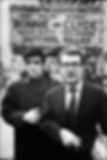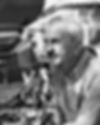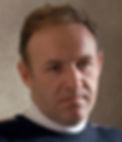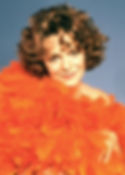113. BONNIE AND CLYDE, 1967
- Jay Jacobson
- Nov 15, 2022
- 20 min read
Updated: Feb 9, 2025
An explosive watershed film that launched a new breed of cinema

“Bonnie and Clyde” was the film that swung open the doors to a new kind of American cinema, leading the way from a star-driven film industry to one driven by the director. The film's unique tone, high energy, and chic style spoke to youth, and its unrestrained sex and violence shattered movie conventions and American movies have never been the same since. This film made movie stars of practically all its leading actors, was a massive hit, and earned ten Academy Award nominations, winning two. It made it onto six of the American Film Institute's (AFI) Greatest Movies lists, including as the 5th Greatest Gangster Film, the 13th Most Thrilling, the 65th Greatest Love Story, and the 27th Greatest American Film of All-Time. Because its groundbreaking aspects have since become part of everyday cinema, it is not as shocking as it was in 1967, but even so, this film remains fiercely bewitching and ever so timeless. And whenever I watch it, it is even better than I remember.

“Bonnie and Clyde” is based on the lives of notorious real-life gangsters Bonnie Parker and Clyde Barrow, who stormed through the central part of the US with their gang in the early 1930s, leaving a trail of robberies, murders, and kidnappings in their wake. Their flamboyant behavior, bank robbing, and cop killing were perpetually sensationalized by newspapers and the two became virtual folk heroes to many of the poor and desperate who felt oppressed by society during the Great Depression. Rather than offer a realistic account of the duo, this film is a romanticized look at the gruesome partnership, turning them into mythic figures. But all glamorization is expertly blended with graphic violence, serving as a reminder that crime indeed does not pay.

The film came about because of its two screenwriters, Robert Benton and David Newman. Benton had been Esquire magazine’s Art Director for a half dozen years or so and wanted a change. He and the magazine’s editor, David Newman, happened to be reading “The Dillinger Days” by John Toland, and in it was a blurb about gangsters Bonnie and Clyde, who went from being outcasts to outlaws. That gave Benton the idea for a film. Heavily influenced by French New Wave films (in particular, those directed by François Truffaut and Jean-Luc Godard), he and Newman wrote a French New Wave influenced screenplay. It was the first screenplay either of them wrote, and earned them each a Best Original Screenplay Oscar nomination. It also began two successful Hollywood careers.

David Newman went on to write (or co-write) such screenplays as "Superman", "Superman II", "Superman III", "What's Up Doc?", "Moonwalker", and his final, "Takedown" in 2000. He died in 2003 at the age of 66. Robert Benton went on to become an esteemed director and screenwriter, and his nomination for "Bonnie and Clyde" was the first of seven career Oscar nominations (five for Best Screenplay and two for Best Director). He would win three Oscars, one for writing "Places in the Heart", and one each for directing and writing "Kramer vs. Kramer”. Other films he wrote and directed include "The Late Show", "Bad Company", "Nadine", "Nobody's Fool", and “Twilight". His other screenplays include "What's Up Doc?", "Superman", and "The Ice Harvest”. As of this writing, Robert Benton is 90 years old.

Benton and Newman first showed their “Bonnie and Clyde” screenplay to Truffaut, who turned it down but told actor/producer Warren Beatty about it. Beatty read the script and decided to produce and star in the film. In turn, he showed it to director Arthur Penn, who had directed Beatty in the 1965 film “Mickey One”. After first turning it down, Penn agreed to direct.

“Bonnie and Clyde” came at a pivotal point in history. Anti-establishment culture was raging and the 1960s were already proving to be a decade of breaking rules, rebellion, and violence. America was at war with Vietnam, the battle for civil rights was growing more turbulent, President John F. Kennedy had recently been assassinated, psychedelic drugs and Timothy Leary were helping drive a counterculture movement, miniskirts were the rage, and women’s liberation and the sexual revolution had begun. Audiences had changed, and the Motion Picture Production Code, which had dictated what could and could not be shown in American films since 1934, was on its very last leg (and would officially be replaced by the Motion Picture Association of America, or MPAA, ratings system in 1968).

“Bonnie and Clyde” is perhaps best remembered for having pushed the envelope in onscreen violence. It had film audiences experience violence more realistically than anything seen before. Special effects advancements (such as squibs - small explosive charges mounted with bags of stage blood that detonated inside an actor's clothes to simulate bullet hits) made bullet shots look more realistic, and Penn has the camera linger as bullets hit, showing people bleeding and making it clear getting shot hurts.

The film initially faced criticism about the violence being graphic and excessive, but one must remember this is a film about gangsters, so by nature it lends itself to violence. And because the nightly TV news showed wounded people, explosions, gunfire, and body bags every day from the war in Vietnam, Penn felt the public had become desensitized to violence and wanted “Bonnie and Clyde” to show it as realistically as possible. In a 1989 interview with NPR’s Terry Gross, Penn stated, "It was a time where it seemed to me that if we were going to depict violence that we would be obliged really to depict it accurately, with the kind of terrible, frightening volume that one sees when one's genuinely confronted by violence”. The film may look tame today, but it was quite shocking in 1967, and influenced the way film violence has been depicted ever since.

Violence wasn’t the only cinematic convention “Bonnie and Clyde” shattered. Penn ignored movie storytelling standards and genre boundaries, breaking unspoken cinematic rules all along the way. His juxtaposition of humor and violence was shockingly unprecedented and confused many who wanted to classify the film as purely gangster. Another genre-bending example is his intercutting of a car chase with banjo music mixed with witness interviews. This was cutting-edge cinema. Though a studio film (Warner Brothers), the production was very much overseen by Penn, giving it an independent feel. Penn mostly shot on location (primarily Texas) with only a few interior shots filmed on studio sets.


This film also pushed the boundaries of sex, with its female protagonist as the sexually aggressive one and a scene of implied oral sex, a taboo subject in American films at that point. There’s a sexual freedom from its opening with “Bonnie” completely naked, to the seduction between her and “Clyde” happening over a gun, symbolically mixing sex with danger. Penn managed to tap into and depict the discontented and alienated youth, and as a result, a younger generation headed back to the movies, both as an audience and as filmmakers. This film made Arthur Penn internationally famous and one of the most influential and innovative film directors of all time. You can read more about Arthur Penn in my post on his earlier classic, “The Miracle Worker”. Just click on the film title to read more.

Being so fresh and trailblazing, “Bonnie and Clyde” became the defining film for a period in cinema known today as the American New Wave (or American Renaissance or New Hollywood). It was a shift from the star-driven films of the Studio Era to ones driven by a film director’s personal style and vision. Just as “Bonnie and Clyde” sported a French New Wave flavor, films from this period were highly influenced by European cinema. Though there is not one way to define films from the American New Wave, they are generally driven by complex characters, share themes of discord or rebellion against the status quo, and have a personal or independent feel and approach to storytelling.

The long list if American New Wave films include "The Graduate”, "Easy Rider", "Rosemary's Baby", "The Last Picture Show", "Harold and Maude", "Five Easy Pieces”, "Night of the Living Dead", "One Flew Over the Cuckoo’s Nest", "Dog Day Afternoon”, “Chinatown", “The Wild Bunch”, and “The Godfather”. It was Hollywood’s second Golden Age, lasting until the early 1980s. New actors emerged, but the movie director was the true star of these films. A new breed of auteur-director was born and flourished, including Sam Peckinpah, George Roy Hill, Roman Polanski, Hal Ashby, Francis Ford Coppola, Woody Allen, Mike Nichols, George A. Romero, Peter Bogdanovich, Martin Scorsese, and at the forefront, Arthur Penn.


One who had a hard time with this new unbridled approach to filmmaking was cinematographer Burnett Guffey. The bulk of Guffey’s career had been at studios where he was used to the controlled environment studio filming provided. The Tennessee-born Guffey began as a camera assistant in 1923, and from 1928 through 1943 worked as a camera operator, becoming a cinematographer in 1944. Prior to “Bonnie and Clyde”, he had already earned four Best Cinematography Oscar nominations and won an Oscar for “From Here to Eternity”. On “Bonnie and Clyde”, he struggled with things like uncontrollable natural light (shadows rolling across landscapes in the middle of a shot) or shooting scenes in low light. Guffey was so frustrated he quit in the middle of production, only to return a week or so later. Good thing he returned, because his work on “Bonnie and Clyde” is spectacular and won him a second (and final) Best Cinematography Academy Award. He continued working until 1971. Of his 103 credits, other films include "All the King's Men", "In a Lonely Place”, “The Harder They Fall", "Birdman of Alcatraz”, "Gidget", "The Madwoman of Chaillot", and "The Great White Hope”. Burnett Guffey died in 1983 at the age of 78.

Penn worked very closely with “Bonnie and Clyde’s” producer and star, Warren Beatty. The two reportedly discussed every scene (often heated), though they worked together quite well. After starring in a half dozen films, Beatty began his own production company in 1965 and was looking for a film to produce when Truffaut mentioned "Bonnie and Clyde". This was the first film Beatty produced and he had a major hand in the film, including casting and promotion. His work on this film, including his first-rate strong, charismatic, vulnerable portrayal of “Clyde”, made Hollywood take notice that he was more than just a dreamy actor, and it earned Beatty his first two Academy Award nominations, one for Best Actor and a second for Best Picture (as producer). He had negotiated to be paid a percentage of the profits, and the film’s enormous success earned him over $6 million.


Virginia-born Warren Beatty loved movies as a child, regularly watching them with his older sister, actress Shirley MacLaine. His sister’s early success prompted him to begin working in the theater, turning down football scholarships to move to New York and study acting with famed teacher Stella Adler. He began appearing on television in 1957, including a recurring role on the hit series "The Many Loves of Dobie Gillis". He took a brief break from TV to appear in his only Broadway show, "A Loss of Roses", which earned him a Tony Award nomination. His first film was starring opposite Natalie Wood in the 1961 Elia Kazan classic "Splendor in the Grass”, which earned him critical praise and a Best Actor Golden Globe nomination, and his handsome looks and self confidence made him an instant success. More leading roles followed, but in less successful films such as Tennessee Williams' "The Roman Spring of Mrs. Stone", "All Fall Down", "Lilith", and Penn's "Mickey One”.

Beatty had a reputation for wanting control on the films in which he appeared, suggesting script changes, lighting ideas, and such, so it was natural for him to want to produce. And as his acting career began losing steam, he took the bull by the horns and began his own production company, which lead to “Bonnie and Clyde”. He was now a serious Hollywood figure. After more starring roles, in 1975 he co-wrote, produced, and starred in the 1975 film "Shampoo", which earned him a third Oscar nomination for Best Screenplay (shared with Robert Towne). He followed with his directorial debut (also writing, producing, and starring), 1978's "Heaven Can Wait", which earned him four more Academy Award nominations (Best Picture, Best Actor, Best Director, Best Screenplay). He finally won the statue for Best Director for the 1981 film "Reds" (also earning nominations for Best Picture, Best Actor, and Best Screenplay). He earned three additional Oscar nominations: Best Actor and Best Picture for 1991's "Bugsy"; and Best Screenplay for 1998's “Bullworth”. To date, Beatty has directed five feature films, cowritten about half a dozen screenplays, and appeared in just over twenty films. In addition to his fourteen Oscar nominations and one win, the Academy awarded him their Irving G. Thalberg Memorial Award in 2000 for his consistently high quality of work as a producer. Other films in which he appears include "McCabe & Mrs. Miller", "Dollars", "The Parallax View”, “Love Affair”, "Ishtar", "Town & Country", and his final film to date, "Rules Don't Apply".

A large part of Beatty’s celebrity were his nonstop affairs with what seemed like practically every famous woman in Hollywood. Just a sampling includes Julie Christie, Diane Keaton, Madonna, Goldie Hawn, Diana Ross, Isabelle Adjani, Brigitte Bardot, Jane Fonda, Joan Collins, Barbra Streisand, Natalie Wood, Vivien Leigh, Leslie Caron, Britt Ekland, Connie Chung, Elle Macpherson, and Carly Simon (who later stated that her hit song “Your So Vain” was written about him). In a 1990 Vanity Fair article, Cher remarked, “Warren has probably been with everybody I know, and unfortunately I am one of them”. Marrying for the first time in 1992, Beatty wed his “Bugsy” costar, Annette Bening, of whom he said it was love at first sight. The two remain married, and have four children. As of the writing of this post, Warren Beatty is 85 years old.

In another of the film’s star making turns, Faye Dunaway gives a powerhouse performance as “Bonnie Parker”, a country girl longing for romance and excited by the thought of danger. Dunaway portrays “Bonnie” with a mesmerizing mix of coyness, frustration, sensitivity, and innocence. One can see it from the film's opening as she looks in the mirror, bangs on her bed, and sprints down the stairs to talk with the handsome “Clyde”. And as they walk to town together, I am wowed by the myriad of genuine emotions pouring out of Dunaway as she tries to keep it cool whilst reacting to “Clyde”. This powerfully performed opening gives the film a solid foundation, and it just takes off from there. This was Dunaway's first major feature film role and it earned her a Best Actress Academy Award nomination and instantly made her an icon and movie star.


Florida-born Faye Dunaway studied dance, piano, and singing as a child. She graduated from Boston University with a theater degree and also studied at the American National Theater and Academy and at HB Studios (an acting school I attended decades later). Her Broadway debut was in "A Man for All Seasons” in 1962, followed by Arthur Miller's "After the Fall" in 1964. She first appeared on television in a 1965 episode of "Seaway", followed by an episode of "The Trials of O'Brien", and landed her first film role in the 1967 comedy "The Happening”, quickly followed by a supporting role in Otto Preminger's "Hurry Sundown". Though both films had finished shooting, neither had yet been released when Penn was searching for "Bonnie". Beatty knew of Dunaway, and though he had major reservations about casting her in the role, he thought she was the type of actress Penn was looking for and suggested her. Penn had seen Dunaway in “After the Fall” and knew she was talented, so he met her, wanted her for the role, and then had to convince Beatty she was right. Dunaway quickly lost thirty pounds so she would look Depression Era poor. Her cool glamour struck a chord with audiences and she became a fashion icon.

Following "Bonnie and Clyde", Dunaway starred in another big hit (and now classic) "The Thomas Crown Affair", in which she again exuded elegance, further establishing her as a fashion icon. Less successful films followed until Penn cast her in 1969's "Little Big Man”, another critical and box-office success. She again appeared in more unsuccessful films, gained a reputation for being temperamental, and her career began to falter. It was revived in 1973 with the hit "The Three Musketeers", followed by the phenomenal “Chinatown" in 1974, which earned her a second Best Actress Oscar nomination and put her back on top. "The Towering Inferno", "Three Days of the Condor" and "Network" followed, all hits, the latter of which landed her a Best Actress Academy Award (her only win to date). "Network" went on to become another supreme classic featuring an outstanding Dunaway performance, cementing her place as one of the top actresses of the 1970s.

In 1981, she played movie star Joan Crawford in "Mommie Dearest", a film version of Crawford's daughter's scathing book about her iconic mother. Dunaway’s larger than life performance turned the film into a certified camp classic, and many credit this role with devastating Dunaway's career (she almost never mentions the film in interviews). In its aftermath, she found it hard to land decent roles or films, with only a few exceptions (such as “Barfly”, “The Handmaid’s Tale”, and “The Rules of Attraction”). So from the 1980s on, Dunaway began appearing more extensively on television and in theater, and in 1994 won an Emmy Award for her appearance on an episode of “Columbo”. She returned to Broadway in 1982's "The Curse of an Aching Heart", and then starred as opera singer Maria Callas in the national tour of Terrence McNally's "Master Class” in 1996, which I was lucky to see (and to this day remember her giving one the greatest performances I've ever seen). Her other films include "The Voyage of the Damned", "Supergirl", "The Twilight of the Golds", "The Champ”, "The Four Musketeers: Milady's Revenge” and she has a new film scheduled for upcoming release, "The Man Who Drew God". Dunaway was married and divorced twice (to lead singer Peter Wolf of the J. Geils Band and to photographer Terry O’Neill). She also famously dated comedian Lenny Bruce and actor Marcello Mastroianni. In 1995, she published her autobiography, "Looking for Gatsby”. As of the writing of this post, Faye Dunaway is 81 years old.

Dunaway and Beatty's chemistry and performances in “Bonnie and Clyde” were such that AFI named "Bonnie" and “Clyde" the 32nd Greatest Movie Villains of All-Time. The two actors reunited at the 89th Academy Awards to present the Best Picture Award. They had been given the wrong envelope and unaware, Dunaway incorrectly announced that "La La Land" had won Best Picture, only to find out a few minutes later that the actual winner was "Moonlight". The snafu made international headlines. They returned the next year to a standing ovation while presenting the Best Picture Oscar at the 90th Academy Awards ("The Shape of Water"), making jokes about their previous year's mixup.

Penn was an actor’s director able to extract the best from his cast, and as a result, all the acting in “Bonnie and Clyde” is sensational, including Michael J. Pollard as “C.W. Moss” of the “Barrow” gang. From his first appearance at a service station, Pollard presents “C.W.” with a fully formed, almost goofy personality and a subtle humor all his own. He says so much without hardly uttering a thing. Pollard’s work earned him a Best Supporting Actor Academy Award nomination (his only). “C.W. Moss” was based on a combination of real-life Barrow gang members W. D. Jones and Henry Methvin.


New Jersey born Michael J. Pollard studied acing at the famed Actors Studio (alongside Marilyn Monroe), made his Broadway debut in "Comes a Day" in 1958, and his television debut that same year in an episode of "Omnibus". His performance in Broadway's 1959's "A Loss of Roses” (with Beatty) caught the eye of Hollywood, and he made his film debut in an uncredited role in the 1959 Doris Day film "It Happened to Jane". That year he also appeared in two episodes of "The Many Loves of Dobie Gillis” with Beatty, and the two had become instant (and lifelong) friends. When casting began on “Bonnie and Clyde”, Beatty thought Pollard perfect for “C.W.”, and Penn agreed, realizing he would add needed comedy into the mix. They were right. It was Pollard’s breakthrough role, and in addition to his Oscar nomination, it remains his best remembered work. He would amass 117 film and TV credits in his 60+ year career, and some of his other films include "Melvin and Howard", "Between the Lines", "Roxanne", "The Russians Are Coming! The Russians Are Coming!", "The Stripper", and "Dick Tracy”. His final film, "The Next Cassavetes", is currently in post-production. His TV work includes appearances on "The Andy Griffith Show", "The Lucy Show", “Gunsmoke", "Lost in Space”, and “Star Trek”. He was married and divorced once, to actress Beth Howland. Michael J. Pollard died in 2019 at the age of 80.


Gene Hackman gives another fantastic performance as “Buck Barrow”, “Clyde’s” brother. Hackman has a warm and engaging aura even as a gangster, and his interplay with Beatty and Estelle Parsons in particular are intoxicating. His very layered performance makes “Buck” feel like a real person. Hackman made his first credited film appearance opposite Beatty in the 1964 film “Lilith”, where Beatty realized Hackman was one great actor. So when casting “Bonnie and Clyde”, he immediately wanted Hackman to play “Buck”. Hackman was appearing on Broadway at the time, so Penn went to see him and the rest is history. “Bonnie and Clyde” was Hackman’s breakout role and earned him his first Academy Award nomination (Best Supporting Actor). It also redirected his then steady television career to a hugely successful and esteemed one in film. Hackman became a star and one of the top actors of the 1970’s, winning a Best Actor Oscar for 1971's "The French Connection". He earned a total of five Oscar nominations in his long career before retiring in 2004. Among his other classics is 1972’s “The Poseidon Adventure”, already on this blog, where you can read more about the life and career of Gene Hackman.

Another striking performances is by Estelle Parsons who plays “Blanche Barrow”, the nervous wife of “Buck”. Her highly energetic, fiery portrayal adds much levity, whether screaming, arguing with “Bonnie”, or running from gunfire with a kitchen spatula in her hand. “Blanche” and “Bonnie” couldn’t be more different from one another and their constant bickering is a welcomed and immensely fun distraction in the midst of a crime spree. Penn had already worked with Parsons and wanted her for the role, knowing she could bring humor. Parsons wasn’t thrilled about taking a supporting part, but as soon as she read it, she realized it was one heck of a role and accepted. She was smart, for it earned her a Best Supporting Actress Academy Award.


Massachusetts born Estelle Parsons studied law, worked as a singer, and was a writer, producer, and commentator on "The Today Show" before turning to acting. Her Broadway debut came as part of the chorus in the 1956 musical "Happy Hunting". Steady stage work followed, with two Obie Award wins and five career Tony Award nominations. Her film and TV work began with an appearance on a 1963 episode of "The Defenders", followed by an appearance in the 1963 film "Ladybug Ladybug". After more TV work, came her Oscar-winning role in "Bonnie and Clyde", which was only her second film and made her a star. Next came a supporting role in the 1968 film "Rachel, Rachel", earning her a second Best Supporting Actress Oscar nomination. Parsons has accrued 55 film and TV credits to date, and her other films include "Watermelon Man", "I Never Sang for My Father" (with Hackman), "For Pete's Sake", "Dick Tracy”, and "Diane". She may be best known today as "Beverly Harris", mother of the title character in the TV sitcom "Roseanne", reprising the role in the series "The Conners". She has also appeared on "Grace and Frankie", "All in the Family", "Archie Bunker's Place", "Frasier", "Law & Order: Special Victims Unit", and "The Good Wife". Theater has been her home for most of her career, and to date Parsons has either acted in or directed just over thirty Broadway productions alone, and was inducted into the American Theatre Hall of Fame in 2004. A method actor who studied at the Actors Studio with famed teacher Lee Strasberg, she later served as one of the Actors Studio’s New York Artistic Directors from 1998 to 2003, and currently holds that position again (since 2015). She's been married twice. As of the writing of this post, Estelle Parsons is 94 years old (and will turn 95 on November 20).


A quick mention of an actor who previously appears on this blog, Gene Wilder, who is riotous as “Eugene Grizzard”, the man whose car the gang steals. This was Wilder’s film debut. Penn knew him from the Actors Studio and saw him on Broadway in “One Flew Over the Cuckoo’s Nest” opposite Kirk Douglas. Beatty also knew Wilder’s work from the stage, and Wilder was reportedly given the role without having to audition. You can read more about the life and career of Gene Wilder in my post on his next film, the classic comedy, “The Producers", which earned him an Oscar nomination. Please check it out.


I would be remiss not to mention the film’s fabulous costumes. “Bonnie’s” carefree, sexy elegance sparked a fashion trend which included bobbed haircuts and berets. The costumes, particularly those worn by Dunaway, infuse a grand sense of style that becomes an essential part of the film. Costume designer Theadora Van Runkle managed to capture the Great Depression Era with a modern, chic sensibility. It was Van Runkle’s first film as a costume designer and earned her an Academy Award nomination for it (her first), beginning a lucrative career. She went on to design costumes for films that include “Bullitt", "The Arrangement", “Mame", and "New York, New York", and earned two addition Oscar nominations for "The Godfather Part II", and "Peggy Sue Got Married". Theadora Van Runkle died in 2011 at the age of 83.

“Bonnie and Clyde” had a rocky road to success. Warner Brothers’ head Jack Warner loathed the film and thought it would fail, so the studio didn’t properly promote it. Respected New York Times critic Bosley Crowther also despised it. He was currently writing a series on violence in American films and felt it glorified violence, stating "It is a cheap piece of bald-faced slapstick comedy that treats the hideous depredations of that sleazy, moronic pair as though they were as full of fun and frolic as the jazz-age cut-ups in ‘Thoroughly Modern Millie’...". Even after the film won accolades and praise, Crowther continued to lambaste it, even making digs at it in reviews of other films. Because New York Times readers were so unhappy with his blasting of the film, after 27 years, the newspaper fired Crowther in early 1968. He was now considered out of touch with current cinema.

Pauline Kael of The New Yorker praised the film, saying that Penn had a “gift for violence”, prompting others to reevaluate it, including Newsweek critic Joe Morgenstern, who originally panned the film and then wrote a second review after watching it a second time, praising it and saying he misjudged it the first time around. The film became a big hit in Europe, and as good reviews began to finally pour in, Beatty had the publicity department create a whole new promotional campaign, and “Bonnie and Clyde” was rereleased in the US less than two months after its original release. It became a giant sleeper hit and Warner Brothers’ second highest grossing film of the time.

This week’s classic gem is immensely entertaining, well-crafted and brimming with an energy and style all its own. Get ready for a mesmerizingly fun ride. Enjoy “Bonnie and Clyde”!
This blog is a weekly series (currently biweekly) on all types of classic films from the silent era through the 1970s. It is designed to entertain and inform movie novices and lovers through watching one recommended classic film a week. The intent is that a love and deepened knowledge of cinema will evolve, along with a familiarity of important stars, directors, writers, the studio system, and a deeper understanding of cinema. I highly recommend visiting (or revisiting) the HOME page, which explains it all and provides a place where you can subscribe and get email notifications for every new post. Visit THE MOVIES page to see a list of all films currently on this site. Please leave comments, share this blog with family, friends, and on social media, and subscribe so you don’t miss a post. Thanks so much for reading!
YOU CAN STREAM OR BUY THE FILM HERE:
PLACES YOU CAN BUY THE FILM:
As an Amazon Associate I earn from qualifying purchases, and any and all money will go towards the fees for this blog. Thanks!!
TO READ AFTER VIEWING (contains spoilers):

In case you are curious, the movie “Bonnie”, “Clyde”, and “C.W.” go to see is the 1933 Warner Brothers musical “Gold Diggers of 1933”. The musical number they are watching is “The Gold Diggers' Song (We're in the Money)” sung by Ginger Rogers. “Bonnie” later sings the song while adjusting her necklace in the mirror.

Penn wanted “Bonnie” and "Clyde’s” deaths to be different from any other in a gangster film, and aimed to achieve a genuine yet lyrical quality and capture how time seems to stretch when you see something terrible. So he filmed the sequence with four cameras running at different speeds to get various degrees of slow-motion and edited them together, keeping the sound of the bullets in real time. The result was considered one of the bloodiest death scenes in all of cinema. It became iconic and has influenced countless films (including “The Godfather” and “Natural Born Killers”). Ending the film abruptly was another very daring move. It forces the viewer to experience the sudden loss of someone, leaving them to grieve.




